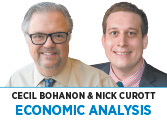Subscriber Benefit
As a subscriber you can listen to articles at work, in the car, or while you work out. Subscribe Now The Bureau of Labor Statistics reported the April Consumer Price Index rose 4.2% on a year-to-year basis. How concerned should we be? The CPI measures the price of a basket of goods and services consumed by the “typical” American household. The basket is indexed to a value of 100 in its base year. Inflation is sustained increase in the CPIi over an extended time frame. This is in contrast with a one-time increase in the CPI.
The Bureau of Labor Statistics reported the April Consumer Price Index rose 4.2% on a year-to-year basis. How concerned should we be? The CPI measures the price of a basket of goods and services consumed by the “typical” American household. The basket is indexed to a value of 100 in its base year. Inflation is sustained increase in the CPIi over an extended time frame. This is in contrast with a one-time increase in the CPI.
Suppose we live in a zero-inflation economy where the CPI has been at 100 for decades. An investor buys a government bond for $100,000 and is promised $115,927 in five years. That computes to a 3% real interest rate on the bond, assuming that the CPI remains at 100.
Now let’s say the CPI rises by 3% per year every year for five years. At the end of year five, the CPI is 115.927 indicating that prices are on average 15.927% higher than in year zero.
Contrast that scenario with the following: The CPI stays at 100 in years 1 and 2, jumps to 115.927 in year 3, and then remains at 115.927 in years 4 and 5.
The former scenario is inflation, the latter is a one-time increase in prices.
At first glance this may appear to be a distinction without a difference. The typical basket of goods and services is 15.927% more expensive in year 5 in both cases. The investor ends with a real return of zero as the increase in the price level erases all her gains.
However, under the inflation scenario investors will likely expect a 3% rise in the CPI in the future, and these expectations will get “baked into” nominal interest rates. Five-year government bonds will have a 6% nominal rate. That’s not so much the case in the second scenario. If the CPI rise is perceived as a one-time event, nominal interest rates most likely stay at 3%.
So what about last week’s news? The Treasury and the Federal Reserve are spinning the story that the CPI spike was more a by-product of unique COVID related realities than an underlying indication of a rising rate of inflation.
We hope they are right, but given the enormous expansion of the monetary base and the Fed’s apparent iron-clad commitment to an easy money policy, we think we are justified in raising our level of inflation concern from yellow to orange!•
__________
Bohanon and Curott are professors of economics at Ball State University. Send comments to [email protected].
Please enable JavaScript to view this content.
